On this Memorial Day, in this dismal low-point in what may well be remembered as one of the worst periods in recent American history, it’s good to remember a time when things were much, much more tangibly horrible.
Seventy years ago today, the evacuation at Dunkirk was reaching its peak – after a fitful start that had some wondering if Britain mightn’t be better off making a deal with Hitler. And with it, the future of Western Civilization was…
…well, not “saved”; wars, as Churchill said, are not won by evacuations. But the events seventy years ago this week sent World War II into a second act.
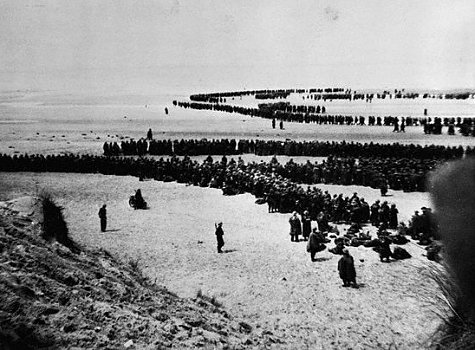
- Troops waiting on the beach
It had been three weeks since Germany had launched its invasion of Belgium and the Netherlands. The feint into Holland with Germany’s second line troops accomplished its mission – drawing the best of the French Army, and the ten divisions of the British Expeditionary Force (BEF), into northern Belgium.

- German scouts with motorcycles and armored cars probe for British and French resistance, 1940
The Germans’ next step – pouring their best Panzer divisions thorugh the Ardennes Forest and driving straight for the English Channel – cut off the BEF and most of the best French troops – the regulars, the North Africans, the twentysomething soldiers – in Belgium.
The troops, cut off from supplies and communications, had to make their way to the Channel, under intense German pressure and constant bombardment from the German Luftwaffe. By the end of May, the British, along thousands of French troops, were trapped in a pocket by the French port city of Dunkirk, right at the Belgian border.
It’s hard to describe how desperate, and fraught, this situation was. The BEF was over 200,000 soldiers and airmen, including the bulk of Britain’s combat power at the time. Losing them would cripple Britain’s war effort. And it seemed very likely that they would lose the BEF. King George VI ordered an unprecedented national week of prayer.
And it was then, starting on May 27, that Churchill – acting through Admiral Bertram Ramsay – ordered one of the most desperate gambles of all time.
-23-11-2005%5Dramsay.jpg)
- Admiral Sir Bertram Ramsay
He ordered Admiral Ramsay to attempt to evacuate the BEF, under fire, from Dunkirk. To facilitate this, Ramsay put out another call – for Britains’ small boat owners, private and commercial, to volunteer their small craft and, if possible, themselves.

- A tug delivers small boats to a Royal Navy base for use in the evacuation. While boat owners operated many of their own craft, many were crewed by Royal Navy sailors rounded up from training and other duties.
The outlook seemed grim. Ramsey’s initial orders were to take two days to try to evacuate 45,000 men. And on the first day, May 27, that looked improbable, with 7,000 men being picked up from the harbor the first day, and maybe 10,000 more the next.
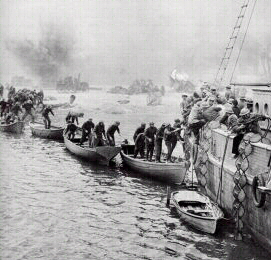
- British troops clamber across boats to get to a larger boat
But by May 30, Ramsey’s plan began to fall into place – aided by the Germans’ acceptance of Hermann Goering’s promise that the Luftwaffe could subdue the Brits alone, freeing up the German tanks to drive south. He used larger ships – especially Britain’s fleet of destroyers, very fast ships that could carry hundreds of men back to safety at nearly 40 miles per hour, but needed the 15-20 feet of underwater room- to go into Dunkirk’s harbor and pick men up off the docks and especially “the Mole”, the harbor’s long breakwater.
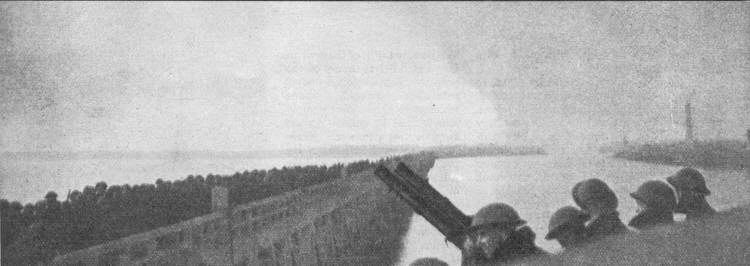
- British antiaircraft gunners watch as troops queue up on The Mole – the long breakwater outside Dunkirk Harbor. Destroyers and larger ships could tie up alongside and load 600 troops in minutes – as opposed to hours spent pulling troops off the beach.
In the meantime his call for “little ships” brought hundreds of smaller boats of all kinds, mostly shallow-draft boats capable of getting to or close to the beaches to pick up the thousands of men waiting there.
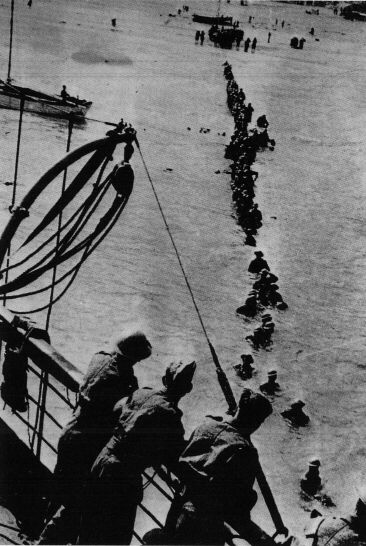
- British troops wading off the beach to rescue. While this is one of the iconic images of the war, the beach accounted for about 1/3 of the rescues at Dunkirk; most were picked up from the docks and the harbor breakwater.
There were all manner of these boats – lifeboats from ocean liners, pleasure boats, trawlers and fishing smacks, dozens of Dutch canal boats that had fled the Netherlands (and carried thousands to safety), much of the UK’s rescue boat fleet, even a Thames river dredge.

- London fireboat “Massey Shaw”, which rescued hundreds from the Dunkirk beaches
Some of the soldiers on the beach in turn built makeshift docks out of the hundreds of army trucks that were going to be abandoned anyway, allowing men to clamber their way out into deeper water to be picked up more easily by the boats.

- Troops of the Royal Ulster Rifles waiting on a “Lorry Jetty” – a dock made out of abandoned trucks.
Between the two – small boats picking men off the beaches, larger ships carrying bulk lots from the harbor- it was seventy years ago today that the evacuation had its biggest day, with 22,000 picked up from the beaches and 45,000 more from the harbor.
The Germans tried to choke off the evacuation; air raids at one point forced the Royal Navy’s destroyers to restrict their entry into the harbor to night-time sorties.

Two days later – days after the supposed deadline, as Hitler finally overruled Goering and sent ground troops in to finish Dunkirk off – the last organized units of the BEF left the continent. The Navy and the little ships were battered by losses – six of the vital destroyers and hundreds of the little ships had been sunk, with many more damaged.

- HMS Grenade, a Royal Navy “G”-class destroyer. She’d rescued a load or two of troops already when she was hit by three Luftwaffe bombs as she picked up troops at the Mole. Towed out to deeper water, she sank seventy years ago last Saturday. The wreck is still there, in 80 feet of water.
The French government was putting immense political pressure on Churchill to evacuate French soldiers and send them, along with as many evacuated French troops as possible, back to France to help defend against the inevitable German offensive into France. So Churchill and Ramsey ordered the evacuation to continue for another day, and then another, taking off mostly French troops as the French rear guard held off the Germans. On June 4, it finally ended with 26,000 final rescues, the last boats leaving as the Germans entered the city, capturing the last of the French defenders.

- French soldiers captured at the approaches to The Mole, June 5. Most of them faced a forced march to Germany to spend the next five years working in German factories and farms. German liberals would have attacked the unconstitutionality of it all, but they were all in concentration camps, and Germany had no constitution.
In total, 338,000 men were rescued from the continent – 88% of the men who’d been trapped in the Dunkirk pocket nine days earlier.
That still left 30,000-odd who were captured – two divisions of the French rear guard, troops that fought until all hope was gone against insurmountable odds, and then only surrendered when ordered – and many British stragglers.

- British POWs at Dunkirk
Still, compared to a week earlier, when it looked as if barely a third of the 45,000 man initial estimate might be saved, it was a miracle.
The French demanded that the rescued British and French troops be sent back to the south of France – but it was a ludicrous request. The troops had left all their artillery, trucks, tanks, and everything heavier than rifles lying in the sand. They were exhausted – as was the Royal Navy. As the last evacuation ships tied up in the UK, the next German offensive – “Plan Red” – that would lead to the capitulation of France, was about to start. More on that on Saturday.

- German troops sort through abandoned British equipment. Some of these rifles would be used five years later, as the German defenders of Berlin frantically tried to beat back the Soviets.
But the evacuation was vital to the war. Britain’s 300,000 best troops went on to fight another day, and serve as the nucleus for the British war effort in North Africa, Italy and, finally, the return to France four years later.

- Dunkirk after the evacuation
Many of the French soldiers returned to France, mostly to become prisoners of war in a few short weeks. But those that remained – the survivors of the best of the French military, the ones that had been sent into Belgium three weeks earlier – formed the nucleus of the Free French Army under Charles DeGaulle. More on them later this week as well.
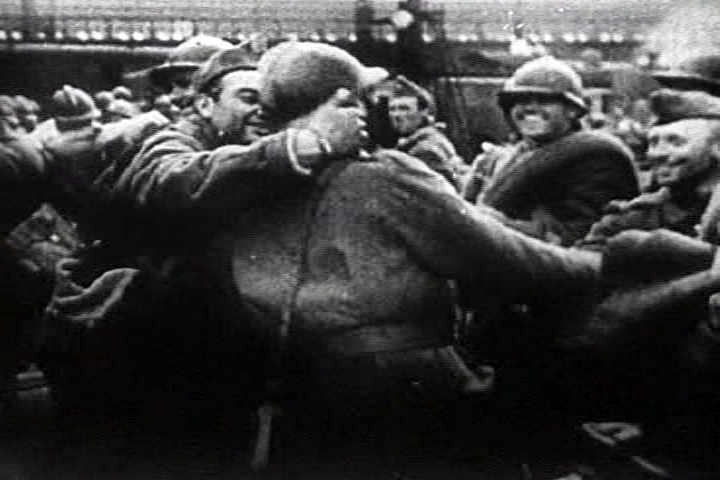
- French evacuees celebrate in the UK
Re-equipping all those British troops accelerated Churchill’s negotiations with the US for “Lend-Lease” equipment – which, in turn, drew the US closer to war with Germany (although in 18 months Pearl Harbor would make that a moot point).
All in all, the evacuation allowed Churchill, on June 4, to make his “Dunkirk Speech” in the House of Commons a rousing, defiant one. Not that Churchill was going to give a defeatist speech in any case – although the British war cabinet did in fact take a vote on seeking terms with Hitler; the evacuation helped make the vote a landside “no”. More on that on Friday, as well.

- Troops return to Britain aboard a RN destroyer
And so while Memorial Day is an American holiday commemorating American troops, it’s worth paying some mind today for the many other people who’ve fought for freedom alongside American troops over the years; the Australians, Danes and Poles who joined us in Iraq; the Lithuanians and New Zealanders who are with us in Afghanistan; the Koreans who have not only defended their own homeland against their psychotic neighbor but joined us in Vietnam 45 years ago (suffering thousands of casualties but beating the Viet Cong on their own turf)…
…and, seventy years ago today, thousands of British soldiers and sailors and weekend fishermen and boat hobbyists who kept Western Civilization alive until help could arrive.

Pingback: Tweets that mention Shot in the Dark » Blog Archive » As You Remember -- Topsy.com
Pingback: The Greenroom » As You Remember Our American Heroes
Pingback: links for 2010-05-31 « Marty Andrade
Mitch, thanks for the research on the heroes of Dunkirk. There are many more unsung champions of freedom that we honor today. I bow my head in thanks for their sacrifices.
Mitch, I love when you ‘do’ military history, it is my second most favorite of your topics, second only to charter schools. Well done! Applause.
Another well done military history read. Thank you Mitch!
Very nice. Among the many little stories in that operation… Among those ferrying troops across the Channel was 66 yr old Charles Lightoller. He ferryed over something like 130 soldiers in a smaller boat. Lightoller had seen Second Officer on the Titanic.
Yep.
Walter Lord’s Miracle of Dunkirk recounts many, many of those stories; he interviewed thousands of Dunkirk vets in the seventies and eighties. Lord, of course, also wrote A Night To Remember, perhaps the definitive Titanic book.
He recounted in particular the story of Lightoller, who adapted the lessons of his son (an RAF bomber pilot who’d been killed earlier in the war) to dodging German air attacks.
If you can find the book (I happen to own a copy), it’s very well worth a read.
Pingback: Shot in the Dark » Blog Archive » And In The Town Halls And At The Polling Stations
Pingback: Shot in the Dark » Blog Archive » And Don’t Think It’s Escaped My Attention…
Pingback: Shot in the Dark » Blog Archive » Improvisation